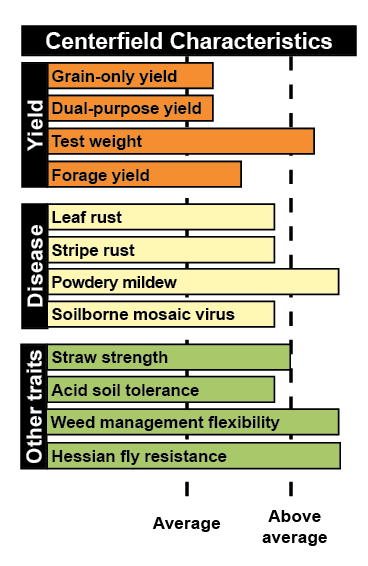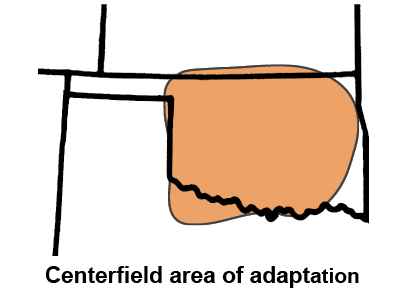Centerfield Herbicide-Tolerant Hard Red Winter Wheat
History
Wheat farmers in the southern Great Plains wishing to use the Clearfield® wheat production system have had limited variety choices. Centerfield improves this list of choices by providing an agronomic package that fits the needs of central Oklahoma wheat farmers.
The Clearfield® trait was initially introduced into hard red winter wheat through the variety TAM 110. So, many early Clearfield® varieties had similar areas of adaptation as TAM 110. Centerfield broke this mold with parentage that is 75% 2174 and 25% TAM 110. The strong 2174 influence in Centerfield means better adaptation to central Oklahoma and improved agronomics. Centerfield has a single-gene that confers resistance to Clearfield® herbicides. Centerfield is marketed and sold by Oklahoma Genetics Inc. through a licensing agreement with OSU.
Yield Potential
Centerfield’s yield performance was better than other Clearfield® varieties tested by OSU in 2006, which was the last year the OSU wheat variety testing program evaluated multiple Clearfield® varieties (Table 1). The good performance in the dual-purpose test in El Reno showcases Centerfield’s better fit in locations with low soil pH.
Test weight of Centerfield has consistently been better than other Clearfield® varieties tested. This makes Centerfield one of the first Clearfield® varieties with test weight that is comparable to its non-Clearfield® counterparts like 2174.
Table 1. Yield (bu/ac) and average test weight (lb/bu) for Clearfield® wheat varieties in the 2006 Oklahoma variety trials.
| Variety | Haskell | Kingfisher | Lamont | El Reno Dual Purpose | Average Test Weight | |
| Centerfield | 44 | 27 | 40 | 42 | 61 | |
| Okfield | 42 | 29 | 39 | 40 | 60 | |
| AP502CL | 38 | 22 | 43 | 37 | 59 |
Current yield data for these and other varieties are available at OSU Wheat
Unique Traits
Centerfield is tolerant to herbicides used in the Clearfield® system, and offers the unique ability manage hard-to-control weeds such as jointed goatgrass. Earlier sowing can create a dense crop canopy and aid in weed control. Early sowing can also increase the risk of Hessian fly damage. Fortunately, Centerfield is resistant to Hessian fly.
Disease Package
Centerfield is resistant to wheat soilborne mosaic virus and wheat spindle streak mosaic virus. Centerfield is moderately resistant to current races of leaf rust and stripe rust. Centerfield shows resistance to powdery mildew but is susceptible to tan spot. So careful attention must be paid to disease management in no-till continuous wheat.
Management
Centerfield’s unique resistance to soilborne diseases and improved test weight make it a good fit for central Oklahoma. Centerfield’s forage production is comparable to other Clearfield® varieties on the market, but it is important to consider the negative impact that grazing might have on weed control in the Clearfield® system.
The strong 2174 influence in Centerfield resulted in heat-sensitive seed dormancy. So, Centerfield is a variety that is better sown after soil temperatures cool in late September. Centerfield closely resembles 2174 in plant maturity and is rated as very late to first hollow stem and medium overall plant maturity.


